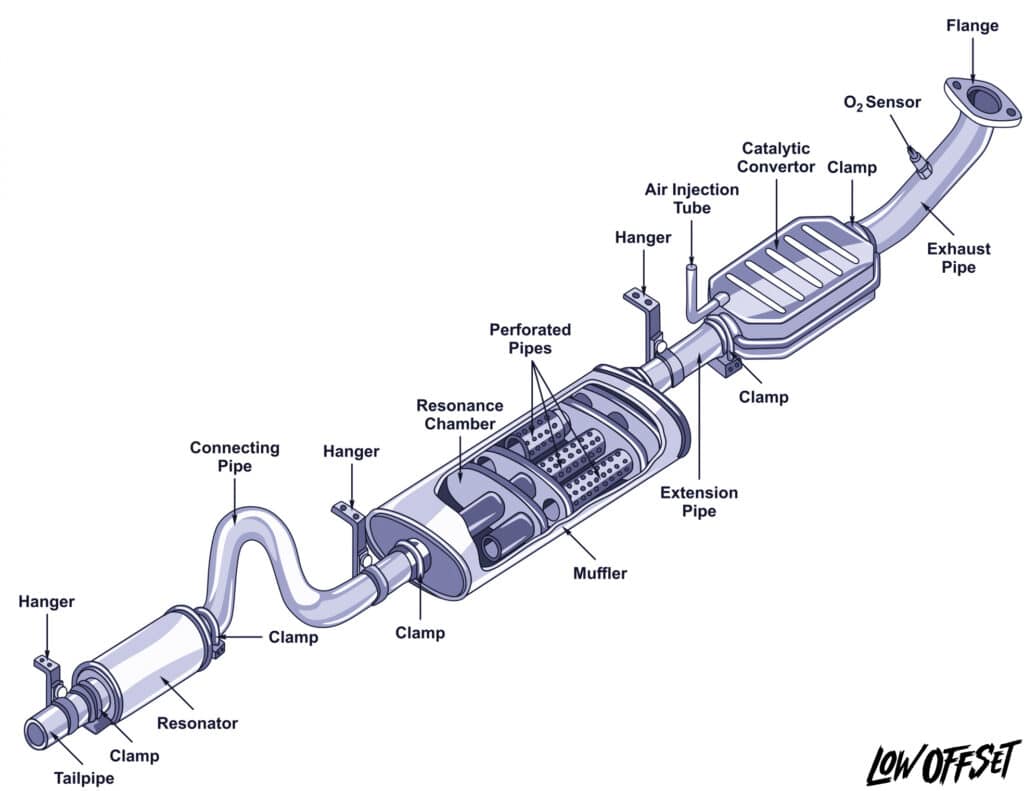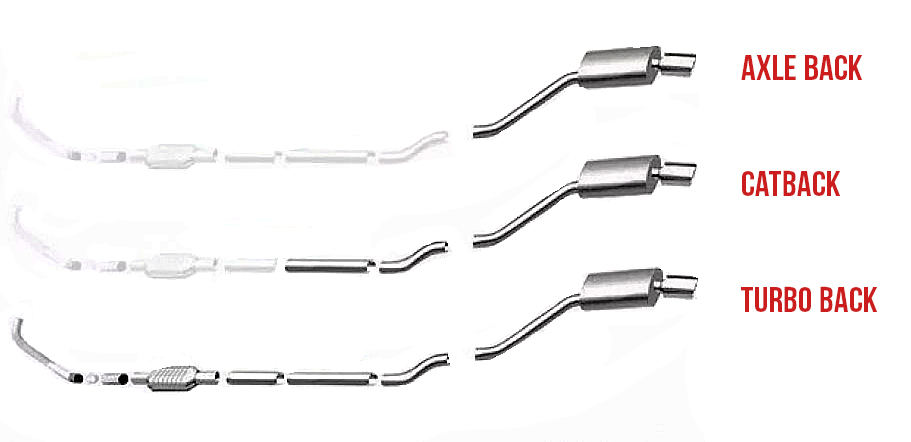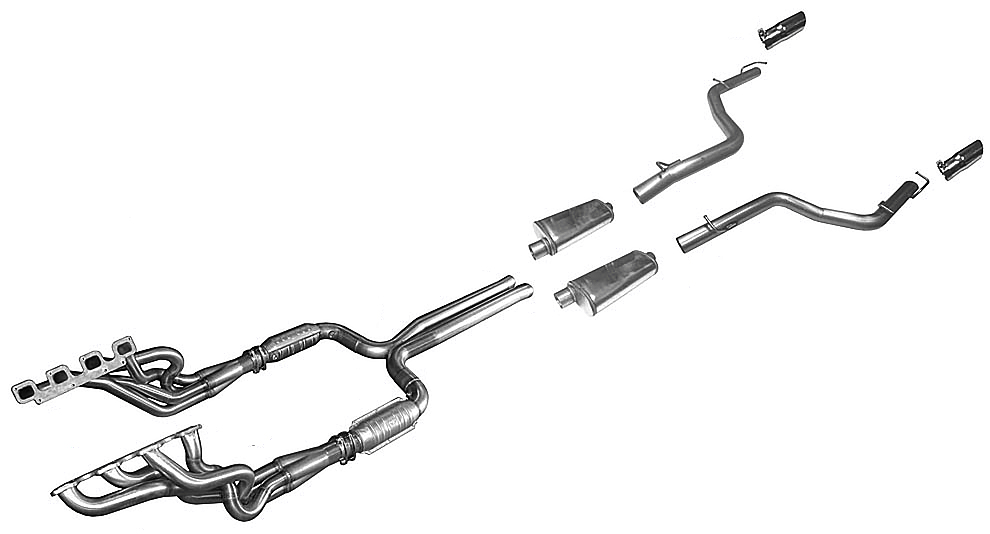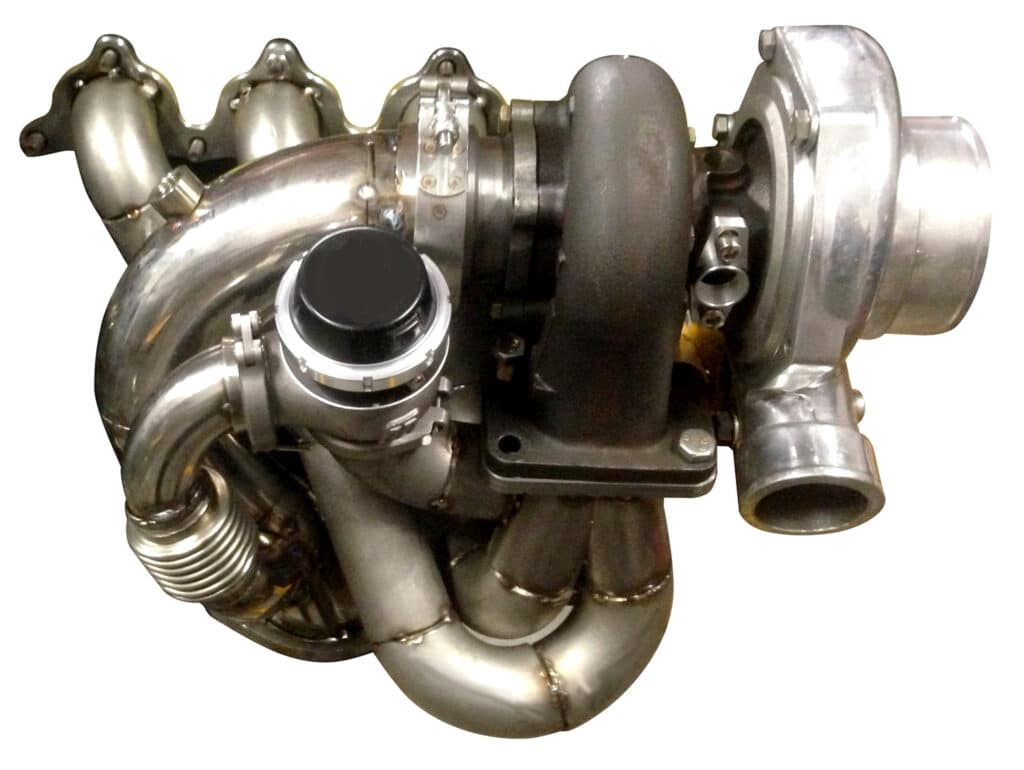In the world of aftermarket exhaust upgrades, catback exhausts hog all the attention, and it’s clear why. They’re cheap, they actually provide a mild improvement in performance, and they sound great.
The same cannot be said about axle back exhausts though. Sure, they improve the sound, but they do nothing to make your car accelerate any faster. Why then do enthusiasts choose one over the other?
There’s a lot you need to know before you can choose the right option for your car. So before you impulsively purchase and install an exhaust system that you’re unsure about, be sure to:
- Understand the basics of how an exhaust system works, and
- Know the difference between catback, axle back, header back, and turbo back exhaust systems.
Point #2 is what we’ll discuss in this guide. Read on as we break this topic down and discuss everything you need to know.
Exhaust Components — A Brief Overview

Before we explain the different types of exhausts, let’s take a quick look at the most important components of the exhaust system:
- Exhaust manifold: The first set of piping that’s connected to the engine.
- Catalytic converter: A complex metal structure that is coated with catalysts that oxidize and clean up exhaust fumes.
- Mid pipe: The pipe that runs between the catalytic converter and the muffler.
- Resonator: A metallic chamber very similar to the muffler — it changes the engine sound in a way that makes it easier for the muffler to work with it.
- Muffler: The metal chamber that is responsible for lowering exhaust volume.
Customizability
One thing we love about exhaust systems is how versatile and customizable they are. You can swap out individual components for aftermarket ones, or you can replace the entire exhaust system.
This means that you have the liberty to upgrade just the headers, catalytic converters, midpipe, muffler; or you can simply install a pre-assembled catback, axle back, or header back exhaust system.
For instance, if most of the restriction in your exhaust system is in the catalytic converter, you can swap it out with a high-flow cat without upgrading anything else. Want a simple, non-invasive way to change your exhaust note? Change your muffler.
You get the idea.
Types of Car Exhaust Systems

In theory, all exhaust systems do the same thing, but the one-size-fits-all approach doesn’t work here.
The components used in exhaust systems and the order in which they’re installed is different on every car. This depends on things like engine layout, emissions requirements, and overall car design — whether it’s a sports car, an SUV, or an economy car.
Then you have single-exit, dual-exit, and true-dual exhausts; there are simply too many permutations and combinations to list.
That said, there is some degree of uniformity in exhaust systems. That’s the reason why it’s possible for manufacturers to design pre-assembled exhaust system types such as catback, axle back, turbo back, and header back.
Let’s take a closer look at what differentiates these.
Catback

- Cat = short for catalytic converter.
- Back = refers to whatever’s installed beyond the catalytic converter.
In other words, catback exhaust systems comprise every component that’s installed after the catalytic converter in the direction of exhaust flow. This includes your midpipe, muffler, and exhaust tip.
Depending on your engine layout, your catback exhaust might come with either an X-pipe, Y-pipe, or H-pipe. It will also include all the necessary installation hardware like gaskets, flanges, nuts, bolts, and hangers.
Installing an aftermarket catback exhaust in place of your stock exhaust system is not as invasive as you might think. You won’t necessarily need to remap your ECU if you keep your stock catalytic converter, but it won’t hurt to get it done anyway.
Wondering why you need a remap if you change your exhaust? Your ECU is tuned to best suit the airflow characteristics of your stock intake and exhaust system. That’s how it figures out how much fuel and air to send to the engine cylinders.
When you drastically change your airflow rate, your ECU needs to be “informed”. That is, it needs to be re-calibrated to suit the exhaust.
You’ll certainly require a remap if you start making major changes in your exhaust system such as installing significantly larger diameter pipes, replacing your catalytic converter with a test pipe, or installing aftermarket headers.
Installing a catback exhaust system will definitely make your car louder. Expect to gain anywhere between 2 to 7 horsepower depending on what you drive and how good your tuning technician is.
Axle Back

Just like “catback”, the name “axle back” follows from the same idea of visualizing exhaust components that are located after a particular part such as the catalytic converter. In this case, it’s the axle.
Axle back exhaust systems include every component installed after the axle. This means it includes just the muffler and the exhaust tip — not a lot going on here.
The only reason why you should choose to install this upgrade is for the sound and looks. Axle back exhausts don’t really add power, and they don’t require a remap.
It’s pretty nifty if you think about it. A simple, safe bolt-on mod that makes your car sound better. No power added, no power lost.
The reason why axle back exhausts don’t add power on most cars is that they only replace the muffler and nothing else. Restriction from the midpipe, catalytic converter, and resonator will still be there.
But remember, these things depend on the car in question. If your car has a super-restrictive muffler, axle back exhaust might add a minuscule amount of power.
Header Back

Header back or full exhaust systems replace everything from the outlet of the exhaust manifold, all the way back to the tailpipe.
Essentially it’s a catback exhaust with an intermediate pipe or a downpipe, along with something to replace the OEM catalytic converter — either a high flow catalytic converter, a resonator, or a test pipe (straight pipe).
The units pictured above are 4-1 headers for an 8 cylinder engine, but 4-2-1 or ‘tri-y’ exhaust headers are also very common for 4 or 8 cylinder engines.
What Is a Turbo Back Exhaust?
Naturally aspirated engines and turbocharged engines have slightly different exhaust system configurations.
For this to make sense, you need to know three things:
- How a turbo works.
- The difference between headers and exhaust manifolds.
- The difference between an exhaust manifold and a turbo manifold.
Let’s go over point number 3 real quick. As mentioned before, exhaust manifolds or headers are the first set of piping that’s connected directly to the engine. When spent gas leaves the engine, it first travels through the exhaust manifold and then to the rest of the exhaust system.
The same is true for turbo manifolds, except for one thing — their outlet is connected directly to the hot side of the turbo, which then splits into two routes:
- Downpipe > catalytic converter > catback system
- Cold side of the turbo > intake manifold > engine cylinder

There’s a reason why they’re designed like that.
When exhaust gases are on their way out at high velocity, they spin the turbine wheel in order to convert exhaust energy into shaft power to drive the compressor. When that happens, the compressor wheel spins and pumps more air into the intake system as a result.
With that in mind, turbo back exhaust systems include all components that are fitted behind the turbo outlet, all the way back to the muffler.
This includes:
- Downpipe
- Catalytic converters
- Mid pipe
- Resonator
- Any other extension / bend pipes
- Muffler
Which Exhaust Type is Better?

Each exhaust type has its merits and demerits. Which type you should choose depends on what you plan on doing with your car.
Is it a daily driver? Do you have more modifications in mind or are you keeping it minimal? Do you want serious gains or just the sound? Answering these questions will help you narrow down your options.
Let’s take a look at how these exhaust types stack up against each other.
Catback vs Axle Back vs Headerback
As we mentioned before, axle back exhausts don’t do much to add power. They’re mostly there just for the sound because they only replace the muffler.
So if you’re in it just for the sound, get an axle back.
But if you’re interested in experiencing a minor bump in power or want something louder and more serious, spend a few hundred more and go for a catback exhaust. Doing this will set the stage for any performance upgrades that you might install in the future.
Catback exhausts really shine when paired with a high-flow catalytic converter or a test pipe; a cold air intake, larger throttle bodies, plenum spacer, and an upgraded fuel system.
If you want to really take your exhaust system to the next level, consider upgrading to a header back system and also look into installing aftermarket headers.
We recommend planning out your upgrades so that they’re synergic and cross-compatible. Pay extra attention to piping diameter and try to avoid bottlenecks.
Turbo Back vs Catback
If you drive a turbocharged car and you only want it to sound better / louder, get a catback or an axle back exhaust.
But if you intend to dial up the boost and install more upgrades like higher capacity fuel injectors, larger throttle bodies, lightweight flywheel, and possibly upgraded engine internals, go for a full turbo back exhaust system.
Final Thoughts

To recap, here’s what each type of exhaust system includes:
- Axle Back: Muffler
- Catback: Midpipe + Muffler
- Header Back: Intermediate Pipe + Resonator / High Flow Cat / Test Pipe + Mid pipe + Muffler
- Turbo Back: Downpipe + Resonator / High Flow Cat / Test Pipe + Midpipe + Muffler
This is more of an oversimplification, though. As mentioned earlier, exhaust system components vary greatly depending on the car and engine in question.
For more reading, check out our other exhaust guides:
- Exhaust Back Pressure Myths Explained,
- Exhaust Systems Explained,
- How To Make Your Exhaust Louder,
- The Exhaust Scavenging Effect, and
- The Key Differences Between a Muffler and a Resonator,
What’s your take on cat back exhaust systems? Do you think this upgrade is worth the money? Let us know in the comments section below!

